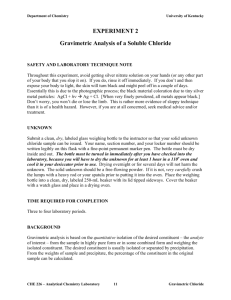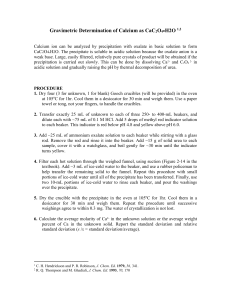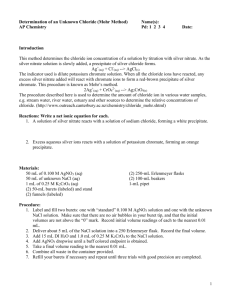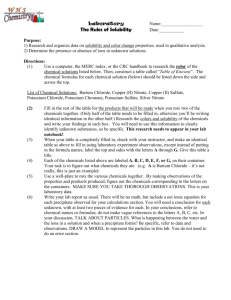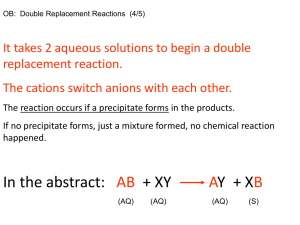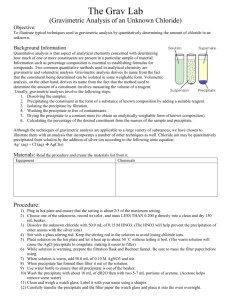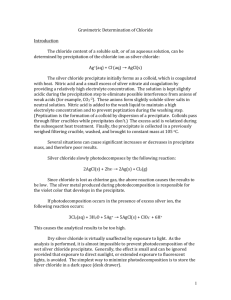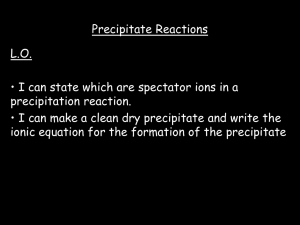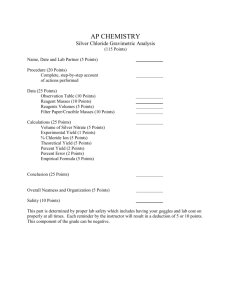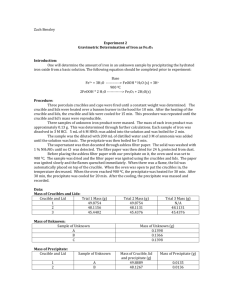Gravimetric Determination of Chloride in a Soluble Salt Mixture
advertisement
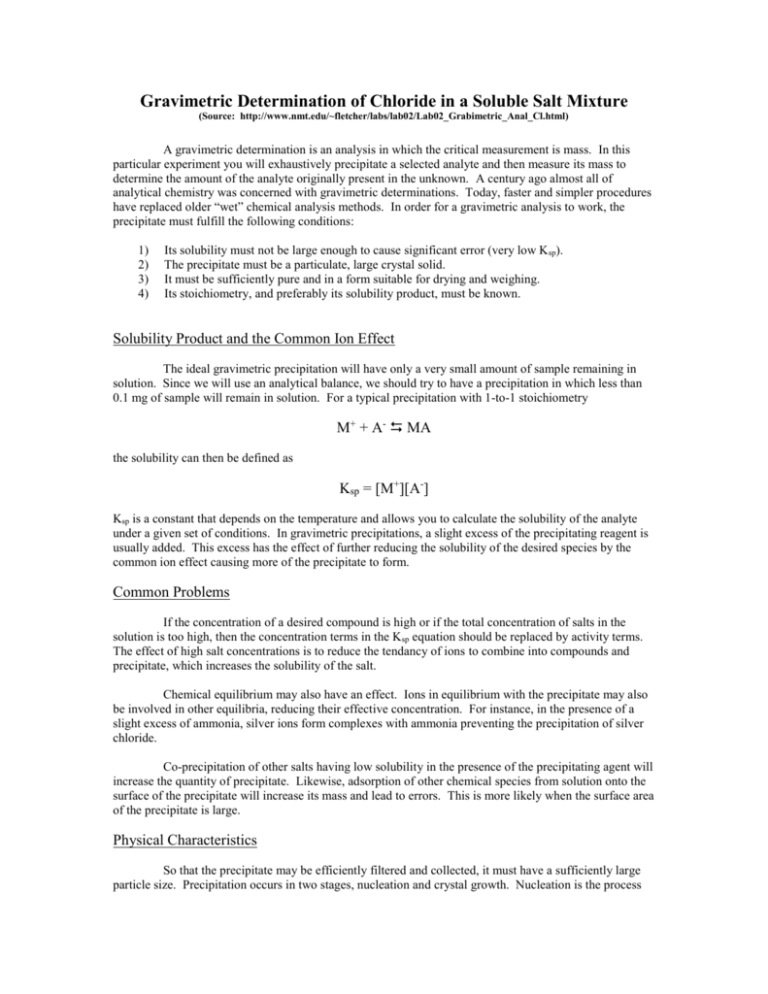
Gravimetric Determination of Chloride in a Soluble Salt Mixture
(Source: http://www.nmt.edu/~fletcher/labs/lab02/Lab02_Grabimetric_Anal_Cl.html)
A gravimetric determination is an analysis in which the critical measurement is mass. In this
particular experiment you will exhaustively precipitate a selected analyte and then measure its mass to
determine the amount of the analyte originally present in the unknown. A century ago almost all of
analytical chemistry was concerned with gravimetric determinations. Today, faster and simpler procedures
have replaced older “wet” chemical analysis methods. In order for a gravimetric analysis to work, the
precipitate must fulfill the following conditions:
1)
2)
3)
4)
Its solubility must not be large enough to cause significant error (very low K sp).
The precipitate must be a particulate, large crystal solid.
It must be sufficiently pure and in a form suitable for drying and weighing.
Its stoichiometry, and preferably its solubility product, must be known.
Solubility Product and the Common Ion Effect
The ideal gravimetric precipitation will have only a very small amount of sample remaining in
solution. Since we will use an analytical balance, we should try to have a precipitation in which less than
0.1 mg of sample will remain in solution. For a typical precipitation with 1-to-1 stoichiometry
M+ + A- MA
the solubility can then be defined as
Ksp = [M+][A-]
Ksp is a constant that depends on the temperature and allows you to calculate the solubility of the analyte
under a given set of conditions. In gravimetric precipitations, a slight excess of the precipitating reagent is
usually added. This excess has the effect of further reducing the solubility of the desired species by the
common ion effect causing more of the precipitate to form.
Common Problems
If the concentration of a desired compound is high or if the total concentration of salts in the
solution is too high, then the concentration terms in the Ksp equation should be replaced by activity terms.
The effect of high salt concentrations is to reduce the tendancy of ions to combine into compounds and
precipitate, which increases the solubility of the salt.
Chemical equilibrium may also have an effect. Ions in equilibrium with the precipitate may also
be involved in other equilibria, reducing their effective concentration. For instance, in the presence of a
slight excess of ammonia, silver ions form complexes with ammonia preventing the precipitation of silver
chloride.
Co-precipitation of other salts having low solubility in the presence of the precipitating agent will
increase the quantity of precipitate. Likewise, adsorption of other chemical species from solution onto the
surface of the precipitate will increase its mass and lead to errors. This is more likely when the surface area
of the precipitate is large.
Physical Characteristics
So that the precipitate may be efficiently filtered and collected, it must have a sufficiently large
particle size. Precipitation occurs in two stages, nucleation and crystal growth. Nucleation is the process
of particle formation and is dependant on a solution that is supersaturated with material. Crystal growth
results from the continuing deposition of material onto the particles.
To ensure that large filterable particles are obtained the number of nucleation sites that are
formed must be limited. This is achieved by mixing the reagents slowly so that the level of supersaturation
is never too high. In addition, if the temperature is raised the solubility is increased and the level of
supersaturation is reduced. Large particles are then formed through crystal growth as the solution cools.
In this experiment you will have a sample of chloride unknown, which you will dissolve in
distilled water. To this you will incrementally add silver nitrate. The silver and the chloride will react to
form insoluble silver chloride which will then be filtered and its mass determined. From the mass of silver
chloride, you can determine the number of moles of AgCl formed, which will allow you to calculate the
number of moles and the mass of chloride in the unknown.
Pre-Lab Calculations – MUST be completed and checked before beginning the experiment
The unknown sample contains between 40 and 70% soluble chloride. Assuming a mass of about
0.2 grams of unknown sample, a 0.2 M solution of silver nitrate and a total final volume of about 120 mL,
calculate the volume of silver nitrate solution that should be added to insure that quantitative precipitation
(>99.9%) of the chloride is obtained. Ignore diverse ion effects and competitive equilibrium. The Ksp of
silver chloride is 1.8 x 10-10 at 25C. HINT: to determine if the precipitation is quantitative, determine if
{[(moles silver added) – (moles silver remaining)]/(moles silver added)}*100% is greater than or equal to
99.9%. If it is, then the precipitation is quantitative.
Experimental
Reagents and Equipment Required
1.
2.
3.
4.
5.
Chloride Unknown: provided, store in a dessicator
Nitric Acid, concentrated
Silver Nitrate, 0.2 M: dissolve 2.6 g AgNO3 in 75 mL distilled water
Precipitate wash solution: add 2 mL conc nitric acid to 250 mL distilled water
3 sintered-glass filtering crucibles (Gooch)
Procedure
Clean Crucibles and bring to constant mass. Each crucible should be cleaned and rinsed
thoroughly with distilled water. If there are still stains on them, they will need to be cleaned with acid.
Each crucible needs to be marked in some manner that will not be rubbed off, removed by heating, or
change in mass. To dry, place the clean crucibles in a beaker – watch glass arrangement and place in the
oven at about 115C for 1 week. Remove the crucibles with tongs (never touch crucibles with your hands
or paper for the duration of the experiment) and allow them to cool for a few minutes before placing them
in a dessicator to cool to room temperature (20-30 min). Weigh crucibles to the nearest 0.1 mg. Return
them to the oven for 2 hours or longer and repeat weighing procedure. This procedure should be repeated
until two consecutive masses agree to within 0.3 mg. It is extremely important that the crucibles be
treated exactly the same way during this procedure as they will be treated when they contain the
precipitate. You will lose credit if you continue the experiment before your crucibles reach constant mass.
NOTE: You need to use the same balance throughout the course of this experiment. Switching balances
when weighing the crucibles will introduce error into your calculations and can be a common cause of
crucibles not coming to constant mass.
Dissolve and precipitate the unknown chloride sample. Record the unknown letter on the
assay sheet and in your notebook. Failure to do so will result in no credit being given for the
completion of this experiment and loss of partial credit for experiment 4. Weigh three individual
portions of the dried unknown sample into three separate clean 400 mL beakers. Each sample of unknown
should weigh about 0.2 g, record its mass to 4 decimal places. Add approximately 100 mL of distilled
water to each beaker to dissolve the sample. Carefully add, with the aid of a stirring rod, 1 mL of
concentrated nitric acid to each solution. A separate stirring rod should be used with each solution and the
stirring rod should be kept in the solution for the duration of the experiment. Heat the solution to about 80
C. Add the amount of silver nitrate calculated in the pre-lab calculation slowly in 8-10 portions. Use the
stirring rod to pour the solution down the side of the beaker. Stir the solution carefully after each addition
of the silver nitrate solution. Any solution or precipitate lost during any of these steps will cause large
errors in the final value.
Allow for Crystal Growth. After completing the addition of silver nitrate, cover the beaker (and
stirring rod) with a watch glass and store in your cabinet until the following week.
Test for completeness. After the precipitate settles, test the clear supernatant solution for
remaining chloride ions by adding a few drops of silver nitrate solution. If additional precipitate does not
form, the precipitation is complete. If precipitate does form, more silver nitrate solution must be added and
the test for completeness must be repeated. Perform this test some time during the week between lab
classes.
Filter the precipitate. Assemble a suction flask and trap for filtration. There are only a few of
these, so you may need to wait until one is available. Insert the crucible into the crucible holder on the
suction flask and apply a gentle suction to the filter assembly. To begin filtration, hold the beaker at an
angle so that the precipitate “nestles” in the lower corner of the beaker and decant the supernatant solution
into the crucible. It is best to pour the solution along the glass stirring rod to avoid missing the crucible or
loss of drops of solution. Never allow the level in the crucible to reach above 2/3 full as the solution tends
to creep upward and particles may be lost over the side of the crucible. When almost all of the supernatant
is decanted through the crucible, wash the AgCl precipitate in the beaker with 3 or 4 -20 mL portions of the
precipitate wash solution. Add the wash solution, swirl the precipitate gently about the flask, and pour
solution to crucible.
Test filtrate for silver ions. Collect a few mL of the last portions of wash liquid coming through
the crucible in a test tube. Add one or two drops of dilute HCl to this filtrate to test for remaining silver
nitrate. If no turbidity (cloudiness) is observed, the filtrate is adequately washed. If cloudiness is observed,
wash the precipitate further. The filtrate can be discarded down the drain with plenty of water.
Dry and weigh the precipitate. Place the crucibles in a beaker – watch glass assembly as before
and allow to dry in the oven several days. Weigh the crucibles as you did earlier. Repeat heating, cooling
and weighing until the mass of each crucible is constant to within 0.3 mg. Once constant mass is
reached, discard the solid in the waste container provided. Do not rinse solid down drain. You will lose
credit if you continue the experiment before your crucibles reach constant mass.
Calculate percent chloride. On the basis of the three separate results, calculate and report the
mean percent chloride in the unknown. Calculate the standard deviation, and the 90% confidence interval.
Eliminate data using the Q-test if needed. Turn in the assay sheet one week after the crucibles-withprecipitate reach constant mass.
Name
Gravimetric Determination of Soluble Chloride
Show a sample of all calculations on the back
UNKNOWN
Mass of Unknown Cl:
1
2
3
Mass of Crucible:
1
2
3
2
3
Mass of Crucible + AgCl: 1
Mass of AgCl:
1
2
3
% Cl- in Unknown:
1
2
3
s:
90:
Average %Cl-:
Why is important to store the crucibles in the dessicator after they are taken out of the oven before they are weighed?
How can you be sure that you have precipitated all of the chloride as AgCl?
How does the common ion effect affect the precipitation of AgCl? What is the common ion?
